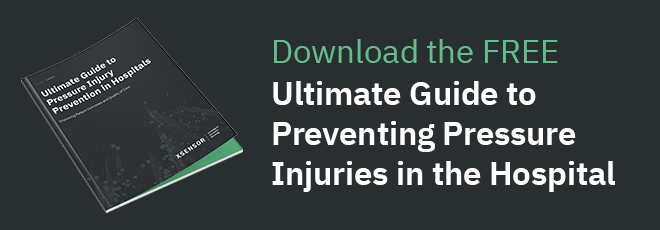
How to Prevent Pressure Injuries with Sensor Mapping
Patient care is no easy challenge. Especially when people are bedridden, keeping them happy and comfortable is tough. Sitting or lying in one place is not only a psychological burden on the patient but also increases the chances of injury from pressure.
Unfortunately, knowing where a surface will contact a body uncomfortably is a difficult prediction to make. Doing so without the right data is nearly impossible, which leaves you reliant on the patient to report their pain – and by then it is already too late.
The answer is pressure injury prevention equipment that combines intelligent pressure mapping sensors with software that allows you to see exactly where friction and shearing occur, and respond to them where necessary.
So how does it work? Let’s take a look.
What Is Preventable Pressure?
Pressure sores occur when bony prominences press continuously against a surface for an extensive period of time. During the days or weeks – or months or years – that some people spend in hospital beds, the skin and tissue start to break down in response to the unrelenting strain.
A patient’s body might look flush and even against a bed, but the truth is much more insidious. Certain areas of the body apply greater forces to the surrounding tissues. Bones that protrude trap thin muscles and skin against the surface of the bed, restricting blood flow and creating sore spots.
Pressure prevention and treatment are critical when the patient is on bed rest. If doctors and nurses fail to respond to shear forces exerted by the bed on the patient and redistribute pressure accordingly, the risk of a pressure injury increases greatly.
Sadly, most of this is preventable pressure. According to recent studies, around 95 percent of all pressure injuries don’t need to happen. With good patient monitoring and the right equipment, we can eliminate them almost entirely. This is important, since pressure can take a serious toll on any patient.
Why Must We Minimize Pressure?
Hampered blood flow can lead to pressure ulcers, which are painful to the patient. They also make proper skin care more difficult. Now, in addition to cleaning the patient, nurses must also disinfect and dress wounds. This increases the chance of infection, which is especially dangerous for high-risk patients.
Not only is it painful and unpleasant, leading to bad associations with medical care, but it also diminishes the body’s ability to heal. Because pain is a type of psychological stress, and studies show that psychological distress slows healing time, it is imperative that medical providers do everything they can to minimize pressure.
Plus, it’s not only the right thing to do for the individual patient, it may even help to increase patient turnover and make more room for new patients. That makes it the right thing to do for the medical system and population overall.
Therefore, preventing and managing pressure is key. Without the right tools and training, though, healthcare workers aren’t equipped to reduce the risk of developing pressure sores. So, what can you do?
How Can You Reduce Pressure Injuries on Support Surfaces?
The main technique to reduce the risk of sores is to use alternating pressure. By switching up the position of the bed and patient, as health care providers, we can reduce the load on the body’s bony prominences, such as the tailbone, hips, ankles and shoulders.
This is easier said than done, however. Without reminders, busy nurses may not know when to do this. Timing is everything, but if they don’t have a system letting them know when it’s time to make an adjustment, they’re left to their best professional judgement – which isn’t always enough. A patient monitoring system is therefore crucial.
But even with alarms and careful charting, the adjustments may not address the problem. If you don’t know where the main pressure is accusing, and therefore doing damage to the skin and tissue, you can’t adjust accordingly. That’s where pressure mapping technology comes in.
What Is Pressure Mapping Technology & Why Does It Matter?
Pressure mapping is just what it sounds like: making a map of an area to see where pressure is applied. In some cases it is low, and the risk of developing a pressure injury is accordingly low. In other places, where a bone or other area of the body protrudes, it is much higher. Hidden against the mattress, though, it’s hard to tell which is which.
Pressure sensor mats placed over the mattress can do much to reduce the mystery. They show exactly where the pressure is occurring, using a matrix of different points to build a complete, data-based picture and send it to the software system. Then all doctors or nurses have to do is look at the real-time pressure image and adjust the patient position or bed accordingly.
Lots of complicated equipment and technology won’t cut it, though. You need a system that addresses every issue without requiring a lot of thought or expertise. A continuous skin monitoring system will include easy-to-use mattress equipment as well as intuitive software.
So where exactly can you find it?
A Complete System to Redistribute Pressure & Reduce the Risk of Pressure Injury
If you’re in the market for a system that can help nurses reduce pressure injuries the vast majority of the time, you’ve come to the right place. XSENSOR’s ForeSite® Intelligent Surface (IS) uses AI-powered continuous skin monitoring technology to build a mattress system that makes ongoing monitoring easy.
This in turn makes it possible for you to individualize care and increase the safety and comfort of patients. It also minimizes the need for doctors and nurses to fuss over the potential of pressure injuries, reducing your overall workload.
Continually relieving pressure through adjustment and alternating elevation of bony prominences allows tissue to re-oxygenate and brings relief to the patient. This in turn helps keep morale up, so they can focus on healing.

